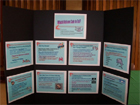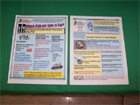April 2008 // Volume 46 // Number 2 // Tools of the Trade // 2TOT2
Creating Quick and Easy Displays for Extension Events
Abstract
Creating quick and easy displays for Extension can be an effective method for reinforcing and disseminating research-based information to consumers. A display of nine power point slides is an effective way to influence consumers. The slides can be laminated and mounted on foam board or displayed on traditional, fabric-covered display panels. Using computer-generated slides allows easy sharing through e-mail to other professionals. Displays can be prepared easily and inexpensively and are effective in reaching consumers with the newest information on a "hot" or traditional topic.
Educational displays have been used successfully to disseminate information to the public. Recently, displays were used as part of a North Carolina community-based BEAUTY and Health pilot project. Displays were used to reinforce targeted health messages toward women given by beauty salon stylists over a 7-week period. After one year, 81% of customers had read the displays in the salons. and 55% made changes in their health habits because of conversations with the stylists and the displays (Linnan, 2007).
Displays increase awareness of nutrition information, as was demonstrated through a 5-A-Day Roadside Market project in Ohio. Extension agents found that laminated posters, along with fact sheets, increased awareness of the 5-A-Day concept among their customers (Mader, 1998). Why choose an exhibit or display to communicate the importance of a particular subject? Obahayujie and Hillison ranked exhibits 15th of the 55 educational methods they tested on the dissemination methods used most by Extension. They concluded that the clientele is best served when its unique characteristics are considered.
When Cornell Extension educators needed to develop a pesticide safety program, a questionnaire was mailed to 57 county Extension offices in New York State. Forty-five responses indicated that the most useful information forms were fact sheets (89% of respondents), newspaper and magazine articles (62%), and portable displays (42%). Because fact sheets and articles were already part of the project, they chose to develop a portable exhibit (Coffman & Watkins, 1991).
Creating effective displays is a challenge for the educator. Typically, they include tabletop or floor models with fact sheets and brochures. They create awareness and provide reinforcement of information to be learned. For this article, the terms "display" and "exhibit" are used interchangeably.
Creating a Display
Before developing a display, the need for it should be documented. Conducting a needs assessment, sending out a questionnaire, facilitating focus groups, or conducting a survey can identify the topic for the display. Surveys can be mailed, e-mailed, or completed by phone. The topic for the display must be researched for the latest information, and then an outline needs to be developed. Pick a message that can be easily demonstrated or illustrated, and outline the key points. Keep messages brief so that viewers can digest the main messages in just a few seconds.
Decide what kind of display board material to use (expensive professional display board or simple, inexpensive foam board). Next, decide whether you will use computer-generated wording and pictures on PowerPoint™ slides or have a professional printer create the display. University print shops or commercial ones can produce the display on large, heavy paper, or on laminated smaller pieces.
Sketch the idea on paper for a rough idea of size, materials, and layout. Then decide whether any other media (e.g., video projectors, computers, tape players) will be added to convey the educational message(s).
Final Display Set-Up
An electrical wall outlet needs to be available if computers or other media is part of the display. The display should include a title, your name, Extension address, and University logo along with bulleted statements or lists that convey the main messages. Make sure the display reads from top to bottom and left to right, like the pages of a book. Illustrations should be big and bold, with easy-to-read lettering. Fact sheets and brochures should reinforce display information.
A Rutgers Cooperative Extension Which Fish Are Safe to Eat? display (Figure 1) was part of an outreach project targeted at pregnant women and small children. The purpose was to warn women of the hazards of consuming recreationally caught fish from the Newark Bay area in New Jersey. These waters are known to have high levels of contaminants. The Rutgers Center for Environmental Communications (RCEC) received a grant to hold focus groups in three cities (Elizabeth, Westfield and Perth Amboy, NJ.) to find out the most effective educational methods to reach pregnant women and their small children.
Figure 1.
Which Fish Are Safe to Eat? Display

The Rutgers Cooperative Extension FCHS Educator, an RCEC consultant, and FDA Public Affairs Specialist worked together to develop the project. Focus groups results directed the collaborators to develop a simple lesson plan that could be taught through WIC or FSNEP/EFNEP Extension classes. See the lesson plan and brochure: Your Baby Eats the Fish You Eat available on-line in English and Spanish <http://www.state.nj.us/dep/dsr/lessonplan.htm>. The focus groups also recommended developing a display in both languages for use at health fairs, schools, local libraries, and WIC offices. A simple, easy to transport, display with one-page handout in both languages was developed (Figure 2).
Figure 2.
Which Fish Are Safe to Eat?
Handout

Constructing Which Fish Are Safe to Eat? Display
The display was developed using foam board, which is light-weight and inexpensive to use. Key concepts were translated into nine simple statements that were formatted as bulleted lists on nine PowerPoint™ slides. The foam board was purchased as a three-panel display and allows just enough room for nine 8 ½ X 11inch slides. Pertinent clip art helps to convey the main points and make each slide attractive. Simple, bold fonts and a catchy title add interest. The one-page handout was developed in Publisher as a colorful take-home information sheet.
Results
Creating this inexpensive and timely display for Extension and WIC audiences has helped to educate several thousand women about eating recreationally caught fish in local waters with high mercury and other contaminants that may not be healthful. Follow-up surveys have indicated that pregnant women with small children have reduced their consumption of recreationally caught fish from the Newark Bay area.
References
Coffman, C., & Watkins, S. (1991). Getting the right stuff into the right hands. Journal of Extension. [On-Line] 29 (1). Available at: http://www.joe.org/joe/1991spring/a5.html
Linnan, L. A. (2005). Using community-based participatory research methods to reach women with health messages: Results from the North Carolina BEAUTY and health pilot project. Health Promotion Practice. 6 (2). ISSN 1524-8399, pp. 164-173.
Mader, S. (1998). 5-a-day roadside market project. Journal of Extension.[On-Line] 36 (6). Available at: http://www.joe.org/joe/1998december/iw5.html
NJDEP. Division of Science, Research and Technology, Your baby eats the fish you eat. Retrieved June 21, 2007 from: http://www.state.nj.us/dep/dsr/lessonplan.htm
Obahayujie, J., & Hillison, J. (1988). Now hear this! Journal of Extension [On-Line] 6 (1). Available at: http://www.joe.org/joe/1988spring/a6.html
